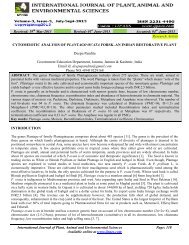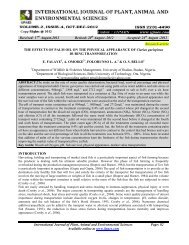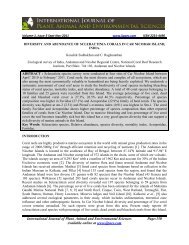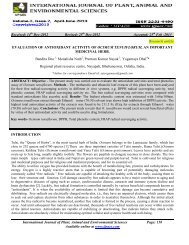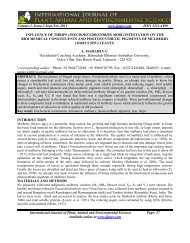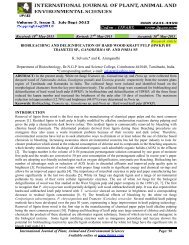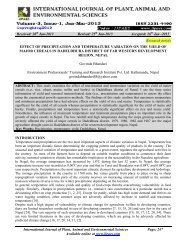endemic trees of western ghatsâa check list from ... - Ijpaes.com
endemic trees of western ghatsâa check list from ... - Ijpaes.com
endemic trees of western ghatsâa check list from ... - Ijpaes.com
- No tags were found...
Create successful ePaper yourself
Turn your PDF publications into a flip-book with our unique Google optimized e-Paper software.
Received: 30 th Mar-2013 Revised: 11 th April-2013 Accepted: 12 th April 2013Research articleENDEMIC TREES OF WESTERN GHATS–A CHECK LIST FROM WAYANAD DISTRICT,KERALA, INDIAVolga V. R. 1 , M. K. Ratheesh Narayanan 1, 2 , N. Anil Kumar 11 M S Swaminathan Research Foundation, Puthoorvayal, Kalpetta 673131, Wayanad Dist., Kerala, India2 present address: Dept. Of Botany, Payyannur College, Payyannur 670327, Kannur Dist., Kerala, Indiavolgacabc@yahoo.<strong>com</strong>, vrvolga@gmail.<strong>com</strong>ABSTRACT: A study was conducted to find out the diversity <strong>of</strong> <strong>endemic</strong> tree species <strong>of</strong> southern Western Ghats inWayanad District <strong>of</strong> Kerala, India. For this several field trips were conducted in all area <strong>of</strong> Wayanad and collectedmaterials for identification. A total number <strong>of</strong> 136 species <strong>com</strong>es under 38 family were recorded. Out <strong>of</strong> these familyLauraceae shows more number <strong>of</strong> plants with 17 species.Key words: Endemic, Western Ghats, WayanadINTRODUCTIONThe Western Ghats is a chain <strong>of</strong> mountains <strong>of</strong> 1600 Km in length running parallel to West cost <strong>of</strong> Peninsular India<strong>from</strong> the river Tapthi to Kanyakumari, the southern tip <strong>of</strong> peninsular India. Western Ghats is one <strong>of</strong> the 33 recognizedecologically sensitive zones in the World, which is a home to 1500 flowering plants, at least 84 amphibian species, 16bird species, 7 mammals and, which are not only found nowhere else in the world, but restricted to specific habitatniches. The significance <strong>of</strong> the Western Ghats is that along with its rich biodiversity, it also supports a richEnvironment-dependant civilization <strong>of</strong> several thousand years. It is estimated that there are four thousand species <strong>of</strong>flowering plants known <strong>from</strong> the Western Ghats and 1,500 (nearly 38 percent) <strong>of</strong> these are <strong>endemic</strong> [4]. Approximately63 percent <strong>of</strong> India’s woody evergreen taxa are <strong>endemic</strong> to the Western Ghats [2]. There are several centres <strong>of</strong> plantendemism and species richness within the Western Ghats. For instance, <strong>of</strong> the 280 woody <strong>endemic</strong> species found south<strong>of</strong> Karnataka, 70 species are <strong>endemic</strong> to the southernmost Travancore region. This high level <strong>of</strong> diversity andendemism in the Western Ghats has conferred on them the hot spots statuses. The southern section <strong>of</strong> Western Ghats isby far the richest area in context to floristic <strong>com</strong>position and concentration <strong>of</strong> <strong>endemic</strong> taxa [7]. Nayar has identifiedthree <strong>endemic</strong> centres in Kerala–Agasthyamalai, Anamalai high ranges and Silent valley–Wayanad.Nearly 4000, or 27% <strong>of</strong> the total plant species in India, have been recorded <strong>from</strong> the Western Ghats [8]. The evergreenforests <strong>of</strong> the Western Ghats are characterized by a very high percentage <strong>of</strong> species <strong>endemic</strong> to the region. The totalnumber <strong>of</strong> <strong>endemic</strong> plant species is estimated to be 1500 (MacKinnon & MacKinnon 1986). Among the evergreen <strong>trees</strong>pecies, 56% are <strong>endemic</strong>. Therefore, the Western Ghats are considered as one <strong>of</strong> the biodiversity hot spots <strong>of</strong> theworld [3]. Species richness and endemism are, however, not uniformly distributed along the Ghats. The southernmostregions which have the most favorable climatic conditions with high, but not excessive, rainfall and short dry seasonare the ones with the highest biodiversity and contain the highest number <strong>of</strong> <strong>endemic</strong> species [9, 12]. Southern WesternGhats is one <strong>of</strong> the two mega <strong>endemic</strong> centres in Western Ghats [7] Kerala form a major species rich part <strong>of</strong> SouthernWestern Ghats harbouring a total <strong>of</strong> 4679 flowering plants out <strong>of</strong> which 1637 are <strong>endemic</strong>s and 483 are <strong>list</strong>ed asthreatened and tree forms form major elements in flora <strong>of</strong> Kerala. A total <strong>of</strong> 1016 tree species are reported to occur inKerala, out <strong>of</strong> which 319 are Western Ghats <strong>endemic</strong> and 171 <strong>list</strong>ed as threatened [16].International Journal <strong>of</strong> Plant, Animal and Environmental Sciences Page: 197Available online at www.ijpaes.<strong>com</strong>
Volga et al Copyrights@2013 IJPAES ISSN 2231-4490MATERIALS AND METHODSStudy AreaWayanad district is with a hilly terrain on the southern Western Ghats and located in the northeast part <strong>of</strong> Kerala at adistance <strong>of</strong> about 76 km <strong>from</strong> the seashores <strong>of</strong> Kozhikode. The area lies between North latitude 11 0 26’ to 12 0 00’ andEast longitude 75 0 75’ to 76 0 56’. The altitude varies <strong>from</strong> 700-2100 metres above MSL. It is bounded on the east byNilgiris and Mysore district <strong>of</strong> Tamil Nadu and Karnataka respectively, on the north by Coorg district <strong>of</strong> Karnataka, onthe south by Malappuram district and on the west by Kozhikode and Kannur districts <strong>of</strong> Kerala. The forest records <strong>of</strong>1887 show that Wayanad had about 75801 acres <strong>of</strong> reserve forest and 111897 acres <strong>of</strong> reserve land. According to theforest department, the present forest cover is about 787 sq. km.MethodologyAn extensive field survey <strong>of</strong> the study area was carried out <strong>from</strong> August 2010 to December 2012 for <strong>list</strong>ing the <strong>trees</strong>pecies. Most <strong>of</strong> the forest areas were covered in accordance with the phonologic period <strong>of</strong> corresponding family forgetting flowering and fruiting specimen for identification. Collected specimens were identified with the help <strong>of</strong> Flora<strong>of</strong> the Presidency <strong>of</strong> Madras [1], The Flora <strong>of</strong> Tamil Nadu, India, Flowering Plants <strong>of</strong> Thrissur Forests [15],Biodiversity Documentation for Kerala. Part 6: Flowering plants. [16], Floristic study <strong>of</strong> Wayanad District givingspecial emphasis to Rare Threatened plants [13].RESULT AND DISCUSSIONBesides many individual publications on rediscoveries and conservation status <strong>of</strong> rare and threatened species <strong>of</strong>Western Ghats, IUCN (2006) published a <strong>check</strong><strong>list</strong> <strong>of</strong> rare and threatened plants <strong>of</strong> Indian region. Southern WesternGhats is the richest area in context to floristic <strong>com</strong>position with 1286 species <strong>of</strong> <strong>endemic</strong> taxa (Nayar, 1996). Thepresent study records 136 <strong>endemic</strong> taxa <strong>com</strong>prising 83 genera <strong>of</strong> 38 families <strong>of</strong> flowering plants. In which moreendemism is seen in family Lauraceae (17species) followed by Rubiaceae and Euphorbiaceae (11 species each),Myrtaceae and Annonaceae (10 species) Anacardiaceae (9 species), Celastraceae (6 species) Ebenaceae,Dipterocarpaceae and Symplocaceae (5 species each), Flacourtiaceae, Sterculiaceae, Meliaceae, Caesalpiniaceae (4species). The details <strong>of</strong> plants are given below.Table-1: List <strong>of</strong> Endemic Trees Recorded.Scientific NameFamilyDillenia bracteata WightDilleniaceaeMagnolia nilagirica (Zenk.) FiglarMagnoliaceaeGoniothalamus cardiopetalus (Dalz.) Hook. f. & Thoms.AnnonaceaeGoniothalamus wynaadensis (Bedd.) Bedd.AnnonaceaeMeiogyne pannosa (Dalz.) SinclairAnnonaceaeMeiogyne ramarowii (Dunn) Gandhi in Sald.AnnonaceaeMetrephora grandiflora Bedd.AnnonaceaeMiliusa nilagirica BeddAnnonaceaeMiliusa wayanadica Ratheesh et alAnnonaceaeOrophea uniflora Hook. f. & Thoms.AnnonaceaePhaeanthus malabaricus Bedd.AnnonaceaePolyalthia fragrans (Dalz.) Bedd.AnnonaceaeCasearia rubescens Dalz.FlacourtiaceaeCasearia wynadensis Bedd.FlacourtiaceaeHydnocarpus macrocarpa (Bedd.) Warb. in Engl. & PrantlFlacourtiaceaeHydnocarpus pentandra (Buch.-Ham.) OkenFlacourtiaceaeInternational Journal <strong>of</strong> Plant, Animal and Environmental Sciences Page: 198Available online at www.ijpaes.<strong>com</strong>
Volga et al Copyrights@2013 IJPAES ISSN 2231-4490Xanthophyllum arnottianum WightXanthophyllaceaeCalophyllum austroindicum Kosterm. ex StevensClusiaceaeCalophyllum calaba L.ClusiaceaePoeciloneuron indicum Bedd.BonnetiaceaeGordonia obtusa Wall.ex Wight & Arn.TheaceaeDipterocarpus indicus Bedd.DipterocarpaceaeHopea erosa (Bedd.) van Sloot.DipterocarpaceaeHopea parviflora Bedd.DipterocarpaceaeHopea ponga (Dennst.) Mabb.DipterocarpaceaeVateria indica L.DipterocarpaceaeCullenia exarillata RobynsBombacaceaePterospermum reticulatum Wight & ArnSterculiaceaePterospermum rubiginosum Heyne ex Wight & ArnSterculiaceaeGrewia heterotricha Mast.SterculiaceaeGrewia umbellifera Bedd.SterculiaceaeElaeocarpus munronii (Wight) MastElaeocarpaceaeVepris bilocularis (Wight & Arn.) Engl. in Engl. & PrantlRutaceaeAglaia barberi GambleMeliaceaeAglaia malabarica Sasidh.MeliaceaeDysoxylum malabaricum Bedd. ex Hiern in Hook. f.MeliaceaeReinwardtiodendron anamalaiense (Bedd.) Mabb.MeliaceaeIlex malabarica Bedd.AquifoliaceaeEuonymus angulatus WightCelastraceaeEuonymus indicus Heyne ex Roxb.CelastraceaeEuonymus paniculatus Wight ex Lawson in Hook. f.CelastraceaeEuonymus serratifolius Bedd.CelastraceaeGlyptopetalum grandiflorum Bedd.CelastraceaeMicrotropis stocksii GambleCelastraceaeOtonephelium stipulaceum (Bedd.) Radlk.SapindaceaeGluta travancorica Bedd.AnacardiaceaeHoligarna arnottiana Hook. f.AnacardiaceaeHoligarna ferruginea MarchandAnacardiaceaeHoligarna grahamii (Wight) Kurz.AnacardiaceaeHoligarna nigra Bourd.AnacardiaceaeNothopegia racemosa (Dalz.) Ramam. in Sald. & Nicols.AnacardiaceaeNothopegia travancorica Bedd. ex Hook. f.AnacardiaceaeSemecarpus auriculata Bedd.AnacardiaceaeSolenocarpus indicus Wight & Arn.AnacardiaceaeOrmosia travancorica Bedd.FabaceaeCynometra beddomei PrainCaesalpiniaceaeCynometra travancorica Bedd.CaesalpiniaceaeKingodendron pinnatum (Roxb.& DC.) Harms in Engl. & Prantl CaesalpiniaceaeHumboldtia brunonis Wall.CaesalpiniaceaeAtuna indica (Bedd.) Kosterm.ChrysobalanaceaeTerminalia travancorensis Wight & Arn.CombretaceaeEugenia argentea Bedd.MyrtaceaeEugenia indica (Wight) Chithra in Nair & HenryMyrtaceaeMeteoromyrtus wynaadensis (Bedd.) GambleMyrtaceaeSyzygium densiflorum Wall. ex Wight & ArnMyrtaceaeInternational Journal <strong>of</strong> Plant, Animal and Environmental Sciences Page: 199Available online at www.ijpaes.<strong>com</strong>
Volga et al Copyrights@2013 IJPAES ISSN 2231-4490Syzygium laetum (Buch.-Ham.) Gandhi in Sald.& Nicols.MyrtaceaeSyzygium malabaricum (Bedd.) GambleMyrtaceaeSyzygium mundagam (Bourd.) Chithra in Nair & HenryMyrtaceaeSyzygium stocksii (Duthie) GambleMyrtaceaeSyzygium travancoricum GambleMyrtaceaeMemecylon randerianum S. M. & M. R. AlmeidaMelastomataceaeMemecylon sisparense GambleMelastomataceaeMemecylon talbotianum Brandis in TalbotMelastomataceaeLagerstroemia microcarpa WightLythraceaeSchefflera racemosa (Wight) Harms in Engl. & PrantlAraliaceaeMastixia arborea (Wight) Bedd. ssp. meziana (Wang.) Matthew CornaceaeCanthium travancoricum (Bedd.) Hook. fRubiaceaeHymenodictyon obovatum Wall. in Roxb.RubiaceaeIxora brachiata Roxb. ex DC.RubiaceaeIxora elongata Heyne ex G. DonRubiaceaeIxora notoniana Wall. ex G. DonRubiaceaeIxora sivarajiana PradeepRubiaceaeLasianthus venulosus (Wight & Arn.) WightRubiaceaeOchreinauclea missionis (Wall. ex G. Don) RidsdaleRubiaceaePavetta travancorica BremekRubiaceaePsychotria nilgiriensis Deb & Gangop.RubiaceaePsychotria truncate Wall. in Roxb.RubiaceaeIsonandra perrottetiana A. DC. in DC.SapotaceaePalaquium ellipticum (Dalz.) Baill.SapotaceaeDiospyros bourdillonii Brandis.EbenaceaeDiospyros candolleana WightEbenaceaeDiospyros nilagirica Bedd.EbenaceaeDiospyros paniculata Dalz.EbenaceaeDiospyros pruriens Dalz.EbenaceaeSymplocos foliosa WightSymplocaceaeSymplocos macrocarpa Wight ex Clarke ssp. kanarana (Talbot) Nooteb SymplocaceaeSymplocos macrophylla Wall. ex A. DCSymplocaceaeSymplocos macrophylla Wall. ex A. DC ssp. rosea (Bedd.) Nooteb. SymplocaceaeSymplocos wynadense (O. Kuntze.) Nooteb.SymplocaceaeChionanthus courtallensis Bedd.OleaceaeChionanthus linocieroids (White) Bennet & RaizadOleaceaeLigustrum perrottetii A. DC. in DC.OleaceaeTabernaemontana heyneana Wall.ApocynaceaeKnema attenuata (Hook. f. & Thoms.) Warb.MyristicaceaeMyristica malabarica Lamk.MyristicaceaeActinodaphne bourdillonii GambleLauraceaeActinodaphne malabarica Balakr.LauraceaeActinodaphne tadulingamii GambleLauraceaeApollonias arnottii NeesLauraceaeBeilschmiedia wightii (Nees) Benth. ex Hook. f.LauraceaeCinnamomum malabatrum (Burm. f.) BlLauraceaeCinnamomum sulphuratum Nees in Wall.LauraceaeInternational Journal <strong>of</strong> Plant, Animal and Environmental Sciences Page: 200Available online at www.ijpaes.<strong>com</strong>
Volga et al Copyrights@2013 IJPAES ISSN 2231-4490Cinnamomum wightii Meisner in DC.Cryptocarya beddomei GambleLitsea beddomei Hook. f.Litsea bourdillonii GambleLitsea floribunda (Bl.) GambleLitsea ghatica Sald.Litsea laevigata (Nees) GambleLitsea oleoides (Meisner) Hook. f.Litsea stocksii Hook.f.Litsea venulosa (Meisner) Hook.f.Helicia nilagirica Bedd.Baccaurea courtallensis (Wight) Muell.-Arg. in DC.Croton malabaricus Bedd.Dimorphocalyx glabellus Thw. var. lawianus (Muell.-Arg.) Chakrab. &Balakr.Drypetes venusta (Wight) Pax & H<strong>of</strong>fmDrypetes wightii (Hook. f.) Pax & H<strong>of</strong>fm.Epiprinus mallotiformis (Muell.-Arg.) CroizatGlochidion ellipticum WightMallotus atrovirens Muell.-Arg.Phyllanthus ind<strong>of</strong>ischeri BennetPhyllanthus megacarpus (Gamble) Kumari & Chadrab.Sauropus saksenianus ManilalArtocarpus hirsutus Lamk.Ficus beddomei KingLauraceaeLauraceaeLauraceaeLauraceaeLauraceaeLauraceaeLauraceaeLauraceaeLauraceaeLauraceaeProteaceaeEuphorbiaceaeEuphorbiaceaeEuphorbiaceaeEuphorbiaceaeEuphorbiaceaeEuphorbiaceaeEuphorbiaceaeEuphorbiaceaeEuphorbiaceaeEuphorbiaceaeEuphorbiaceaeMoraceaeMoraceaeACKNOWLEDGMENTThe authors are grateful to Pr<strong>of</strong>. M S Swaminathan, Chairman and Dr. Ajay Kumar Parida, Executive director <strong>of</strong> M SSwaminathan Research Foundation, Chennai, India for providing facilities and support. Extended thanks to Sir DorabjiTata Trust, Mumbai, for the research grand. We thank to Kerala Forest Department for the field level help and all staffmembers <strong>of</strong> Community Agrobiodiversity Centre, M S Swaminathan research Foundation, Wayanad.REFERENCES[1] Gamble, J. S. 1915 -1936, Flora <strong>of</strong> the Presidency <strong>of</strong> Madras, Adlard & Sons Ltd., London, Vols 1–3.[2] Johnsingh, A.J.T. 2001. The Kalakad-Mundanthurai Tiger Reserve: A global heritage <strong>of</strong> biological diversity.Current Science. 80 (3): 378-388.[3] Myers, N. 1988. Threatened biotas: “hotspots” in tropical forests. Environmenta<strong>list</strong> 8: 1-20.[4] Nair, N.C. and P. Daniel (1986). The floristic diversity <strong>of</strong> the Western Ghats and its conservation: A review.Proceedings <strong>of</strong> the Indian Academy <strong>of</strong> Sciences (Animal Science/Plant Science) Supplement 127-163[5] Narayanan, M.K.R., Sujanapal, P., Anil Kumar, N., Sasidharan, N. & Sivadasan, M. (2010b) Miliusawayanadica (Annonaceae), a new species <strong>from</strong> Western Ghats, India. Journal <strong>of</strong> the Botanical ResearchInstitute <strong>of</strong> Texas 4:[6] Nayar, M.P. & A.R.K. Sastry, (eds.) 1988. Red Data Book <strong>of</strong> Indian Plants, Botanical Survey <strong>of</strong> India, Calcutta.[7] Nayar, M.P. 1996. Hot Spots <strong>of</strong> Endemic Plants <strong>of</strong> India, Nepal and Bhutan. Tropical Botanical Garden andResearch Institute, Thiruvananthauram, India.International Journal <strong>of</strong> Plant, Animal and Environmental Sciences Page: 201Available online at www.ijpaes.<strong>com</strong>
Volga et al Copyrights@2013 IJPAES ISSN 2231-4490[8] Nayar, T.S., A. Rasiya Beegam., N. Mohanan. , G. Rajkumar. 2006. Flowering plants <strong>of</strong> Kerala. TBGRI,Trivandrum[9] Pascal, J.P. 1988. Wet Evergreen Forests <strong>of</strong> the Western Ghats <strong>of</strong> India. Inst. fr. Pondichéry, trav. sec. sci. tech.Tome 20.[10] Pascal, J.P., B.R. Ramesh& D. De Franceschi. 2004. Wet evergreen forest types <strong>of</strong> the southern Western Ghats,India, Tropical Ecology 45(2): 281-292.[11] Ramachandran, V.S & V.J.Nair. 1988 Flora <strong>of</strong> Cannanore. Botanical Survey <strong>of</strong> India, Calcutta.[12] Ramesh, B.R., J.P. Pascal & D. De Franceschi. 1991. Distribution <strong>of</strong> <strong>endemic</strong> arborescent evergreen species inthe Western Ghats. Pp.20-29. In: Kerala Forest Department (ed) Proceeding <strong>of</strong> the Rare, Endangered andEndemic Plants <strong>of</strong> the Western Ghats.[13] Ratheesh Narayanan, M. K. 2009, Floristic study <strong>of</strong> Wayanad District giving special emphasis to RareThreatened plants (Unpublished thesies, University <strong>of</strong> Calicut).[14] Sasidharan, N. 1987. Forest <strong>trees</strong> <strong>of</strong> Kerala A <strong>check</strong><strong>list</strong> including exotics. Kerala Forest Research Institute,Peechi.[15] Sasidharan N, Sivarajan VV (1996) Flowering Plants <strong>of</strong> Thrissur Forests. Scientific Publishers,Jodhpur. pp.265-266.[16] Sasidharan, N. 2004. KFRI Handbook, No. 17; Biodiversity documentation for Kerala. Part 6: Flowering plants.International Journal <strong>of</strong> Plant, Animal and Environmental Sciences Page: 202Available online at www.ijpaes.<strong>com</strong>



